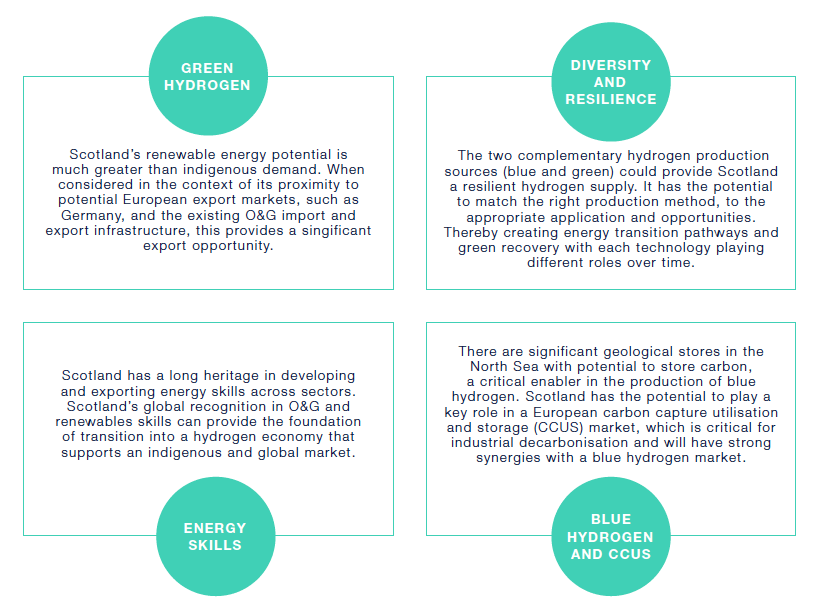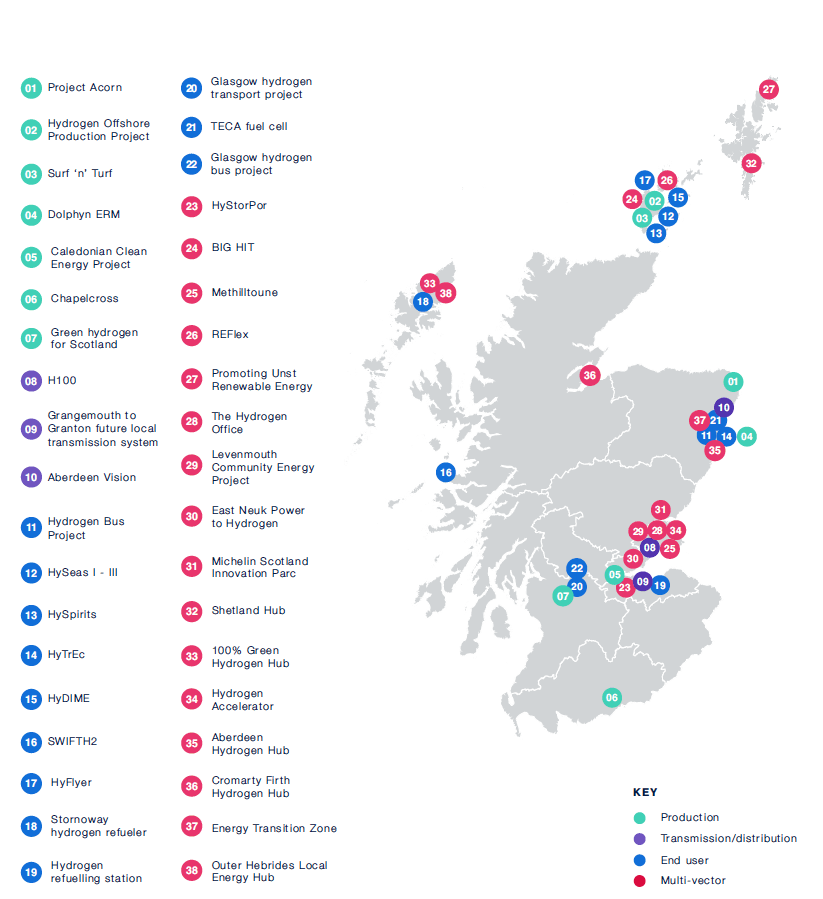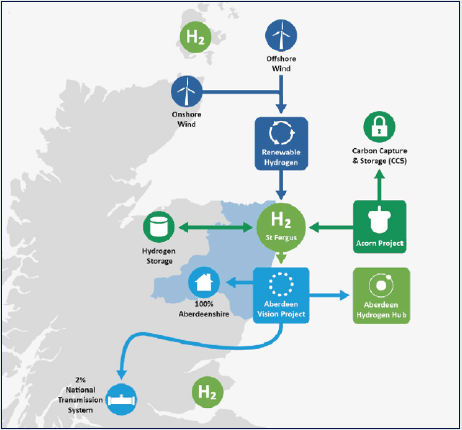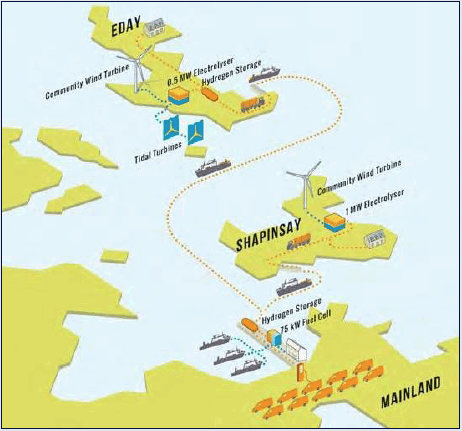Scottish hydrogen: assessment report
Examines how applications of hydrogen-based technologies in transport, industry, heat and whole system approaches can best be deployed in Scotland.
3 A Scottish Hydrogen Economy
3.1 Scotland's potential
The Scottish hydrogen story is not just about the potential to decarbonise. It is about using Scotland's natural capital to achieve the Scottish Governments stated aim "to achieve a Just Transition to net zero, by ensuring everyone can benefit from the opportunities and no one is left behind" and a green economic recovery post Covid-19. Scotland has a range of competitive advantages which can enable an ambition to secure an influential role in a global hydrogen economy.
More broadly Scotland represents an attractive location for investment opportunities in the energy sector. It has a stable planning regime, energy policy, government support, skilled workforce, good infrastructure, a mix of industrial, commercial and domestic demands, limited constraints on water resources, and a track record in research and innovation.

3.2 Scotland's experience
There is rapid acceleration of a hydrogen economy globally, with several nations developing and delivering on hydrogen strategies that match their existing strengths and natural capital. Scotland has already made significant progress on the global stage in creating the foundations of a transition, with a number of world leading demonstration and development projects. In order to maximise the captured economic benefits, Scotland will need to accelerate support and commitment in areas that match Scotland's strengths.
There is a clear and strong appetite from industry to develop and commercialise a hydrogen industry in Scotland, including comprehensive demonstration and early commercial projects in development, construction and operation, shown in Figure 12 and detailed in Appendix A1.1. Scotland's innovative, agile, entrepreneurial, and community led skills can be best seen in the aspirations of the Scottish Islands including Orkney and the Western Isles.
“The supply chain in Scotland which currently services heavy industry and the energy sector should be well positioned to support progress in the hydrogen industry. These supply chain lines have shown a prior ability to reshape themselves to support new industries (e.g. offshore wind), although as ever governmental support for this transition and a focus on encouraging local content will be key”
Stakeholder questionnaire opinion

3.3 Scotland's regional solutions
The deployment of hydrogen in Scotland is likely to be region and geography specific, reflecting the location of production resources, existing infrastructure and demand patterns. The trends in region specific solutions are reflected in the emerging demonstration and development projects shown in Figure 12 with distinct characteristics in island and rural locations, industrial clusters and urban centres.
Hydrogen offers an opportunity for rural and island communities, where a whole systems approach could allow efficient decarbonisation, while creating local economic benefits.
Scotland's island and rural locations have access to vast renewable resources. Despite this, they suffer from high fuel costs resulting in high levels of fuel poverty. This is due to a combination of factors including constrained electricity grids, limited penetration and/or interconnection of gas grids and the high costs of transporting fuel. High fuel prices and carbon intensive fuels, have a negative impact on energy intensive industries and commercial activities such as the whisky and distilling sectors.
An integrated energy system that includes hydrogen can allow better local management of supply and demand, allowing an increasing penetration of renewables in the system. Examples of this approach are emerging in the Western Isles and Orkney where hydrogen is being developed as a solution that can supply an increasing diversity of demands alongside increasing electrification.
In addition, proximity to large scale offshore renewables, may allow islands and rural locations to play a key role in production and export of hydrogen to the rest of Scotland, UK and Europe.
Scotland's industrial clusters represent numerous co-located and localised heavy industry units with diverse processes including chemicals, petrochemicals/refineries, manufacturing, food and drink, cement, paper and pulp, and glass.
These processes are often difficult to decarbonise as they have limited options in terms of low carbon solutions. This is particularly the case where a high temperature is required or a specific feedstock is essential for the chemical process. Some of Scotland's industrial clusters already have grey hydrogen facilities, including the Grangemouth site, which is Scotland's largest carbon emitter.
Industrial clusters are likely to require integration with CCUS infrastructure as a solution for processes that cannot be decarbonised by other means. This provides an obvious synergy with blue hydrogen production, where CCUS infrastructure can be shared and hydrogen can be used as an alternative to natural gas or a process feedstock.
The most advanced industrial cluster focused on blue hydrogen is the St Fergus site, which includes the Acorn CCUS and blue hydrogen production projects. However, current and previous hydrogen production and CCUS projects have been investigated in the Shetland Energy Hub and Caledonia Clean Energy Project (Grangemouth).
Scotland's urban centres have different challenges to rural areas. They are well connected to national energy infrastructure but have more limited access to resources in proximity. Their dense population allows for economies of scale in creation of demand and makes investment in new infrastructure more feasible. In cities, improvement in air quality becomes a significant driver in policy decisions as value is achieved not just in decarbonisation but health benefits.
An example opportunity is the switch to hydrogen for public sector fleets within a city, where a scalable demand can be created, and investment in refuelling infrastructure becomes more viable as utilisation is higher. Injection of hydrogen or full conversion of the gas networks, to provide domestic and commercial heating, would present a significant scale of demand to justify investment in production at scale.
One such example is Aberdeen's commitment to demonstrating and developing hydrogen, especially within transport. Since 2014, the original fleet of 10 hydrogen buses has stimulated the uptake of 64 smaller hydrogen vehicles into operation. A further 15 buses are due to arrive in 2020, with an additional 10 hydrogen buses being added to the fleet in 2021. The longer term vision includes deployment in a wider range of sectors including heat, rail and marine. They are also looking to increase supply of green hydrogen in addition to connectivity with the Acorn blue hydrogen project (see Hydrogen Coast case study for more details). Glasgow and Dundee have similar ambitions with early focus on decarbonisation of public sector vehicles.
This combined approach of island, urban and industrial cluster projects, provides the building blocks towards development of a hydrogen economy. Over time production and demand will increase and it is anticipated that the infrastructure associated with disparate regions will become increasingly integrated. This is reflected in long term visions of deployment, such as the Hydrogen Coast19, where industrial and rural projects are expected to grow and integrate to increasingly serve urban centres.
Hydrogen Coast case study
The Hydrogen Coast is a concept which aims to work with a cluster of projects that are delivering innovative hydrogen solutions along the east coast of Scotland. It is bringing together hydrogen projects to demonstrate full transition to the hydrogen economy, encompassing both blue and green hydrogen options.

The programme is being led by Scotia Gas Networks (SGN), National Grid and Pale Blue Dot along with the partners of the hydrogen projects that are already underway across the east coast of Scotland:
- Acorn Hydrogen and Acorn CCUS – A blue hydrogen production plant producing hydrogen from natural gas landed at St Fergus, coupled with a CCUS facility that will capture the CO2 from hydrogen production, as well as other sources, and transport it for storage in the North Sea.
- HyStorPor – Investigating the requirements for the geological storage of hydrogen. This work will support the development of hydrogen storage for Acorn Hydrogen and other Hydrogen Coast projects.
- Aberdeen Vision Project – Using hydrogen from the Acorn Hydrogen project to support decarbonisation of the national and Aberdeenshire gas transmission systems. Phase 1 proposes all gas leaving St Fergus would be injected with 2% hydrogen. Phase 2 aims to inject up to 20% hydrogen into the gas supply for Aberdeen and the Aberdeenshire region. Phase 3 aims to operate the low pressure network on 100% hydrogen.
- H100 – SGN are developing the first 100% hydrogen domestic network, in Fife. This project is building an evidence base for domestic hydrogen use and will facilitate larger trials such as that proposed in the Phase 3 of the Aberdeen Vision Project.
- Aberdeen Hydrogen Bus Project – Currently operating a fleet of buses in Aberdeen powered by green hydrogen.
- The Hydrogen Hub, Aberdeen - Aims to secure a resilient and cost effective supply of green hydrogen, initially for a fleet of road vehicles, in support of the Hydrogen Bus Project and other fleet vehicles. Subsequent project phases are looking to supply marine and rail customers with green hydrogen.
- Dolphyn ERM - is exploring the possibility of using deepwater floating offshore wind assets to produce hydrogen at sea and then pipe it to shore using existing O&G infrastructure[20]. Supplying additional hydrogen into the Hydrogen Coast projects.
- Dundee Bus Project – introducing hydrogen buses to Dundee. This project provides an additional hydrogen demand along the east coast.
- Several projects in Orkney, see Orkney case study.
Orkney case study
Orkney's existing and developing projects demonstrate an island approach to growing a hydrogen economy, in building block stages.
The initial Surf 'n' Turf project delivered a 500 kilowatt (kW) green hydrogen production facility on the Isle of Eday. The hydrogen is produced using tidal power from deployed turbines at the European Marine Energy Centre (EMEC), along with 900 kW community wind generation. The hydrogen is stored and transported to Kirkwall harbour, where it is used by a fuel cell to provide electricity to docked ships in the port.
Following this, the Building Innovative Green Hydrogen Island Territories (BIG HIT) project expanded on the idea of whole energy system thinking, at a local level. It aims to demonstrate that the approach can be replicated at other rural locations. Green hydrogen is produced by electrolysers on Eday (0.5 megawatt (MW)) and Shapinsay (1 MW), supplied by onshore wind, and is then stored in tube trailers for transportation to mainland Orkney. Launched in 2018 when fully commissioned 50 tn of hydrogen will be produced annually for local buildings and transported to Kirkwall for heat and power of harbour buildings, the marina, vessels and a refuelling station for road vehicles.
From these projects, numerous others have grown and are demonstrating hydrogen demand in ferries (HySeas III[21], HyDIME[22]), aviation (HyFlyer[23]) and distilleries (HySpirits[24]). The Hydrogen Offshore Project[25] on Flotta Island is also considering incorporation of O&G infrastructure. Wider energy system integration is being explored through ReFlex[26] which is exploring the potential of both hydrogen and increased electrification alongside smart management of the system to bring more renewable energy online.

Contact
Email: onshoreoilandgas@gov.scot
There is a problem
Thanks for your feedback